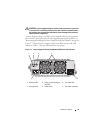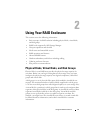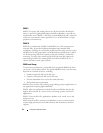
Using Your RAID Enclosure 33
Segment Size
Disk striping enables data to be written across multiple physical disks. Disk
striping enhances performance because striped disks are accessed
simultaneously.
The segment size or stripe element size specifies the size of data in a stripe
written to a single disk. The MD3000i supports stripe element sizes of 8, 16,
32, 64, 128, 256, and 512 KB. The default stripe element size is 128 KB.
Stripe width, or depth, refers to the number of disks involved in an array
where striping is implemented. For example, a four-disk disk group with disk
striping has a stripe width of four.
NOTE: Although disk striping delivers excellent performance, striping alone does
not provide data redundancy.
Hot Spares and Rebuild
A valuable strategy to protect data is to assign available physical disks in the
storage array as hot spares. A hot spare adds another level of fault tolerance to
the storage array.
A hot spare is an idle, powered-on, stand-by physical disk ready for immediate
use in case of disk failure. If a hot spare is defined in an enclosure in which a
redundant virtual disk experiences a physical disk failure, a rebuild of the
degraded virtual disk is automatically initiated by the RAID controller
modules. If no hot spares are defined, the rebuild process will be initiated by
the RAID controller modules when a replacement physical disk is inserted
into the storage array.
Global Hot Spares
The MD3000i supports global hot spares. A global hot spare can replace a
failed physical disk in any virtual disk with a redundant RAID level as long as
the capacity of the hot spare is equal to or larger than the size of the
configured capacity on the physical disk it replaces, including its metadata.
Hot Spare Operation
When a physical disk fails, the virtual disk automatically rebuilds using an
available hot spare. When a replacement physical disk is installed, data from
the hot spare is copied back to the replacement physical disk. This function is


















